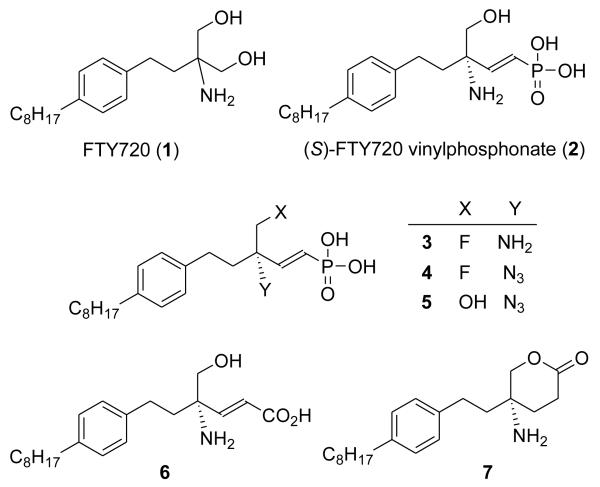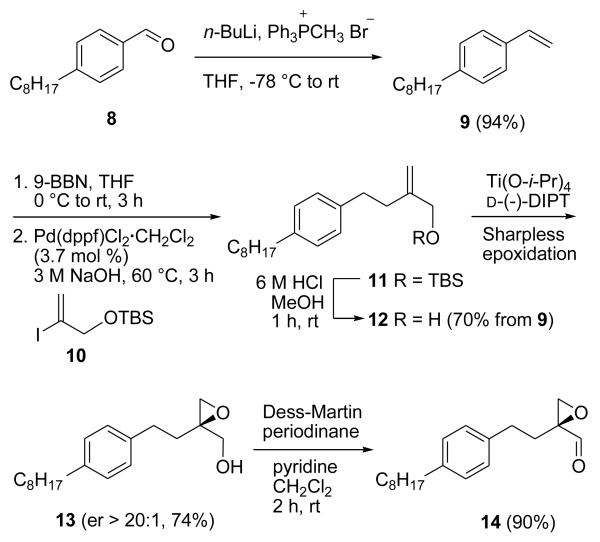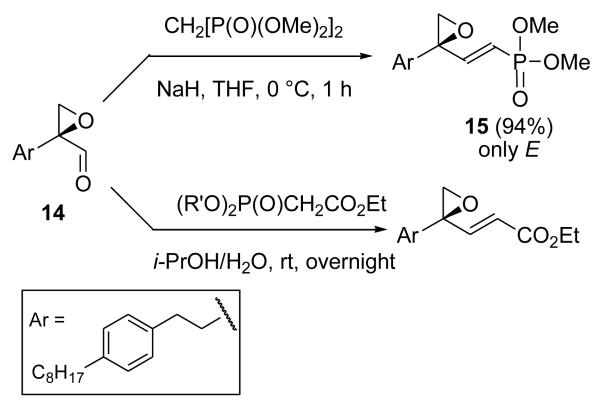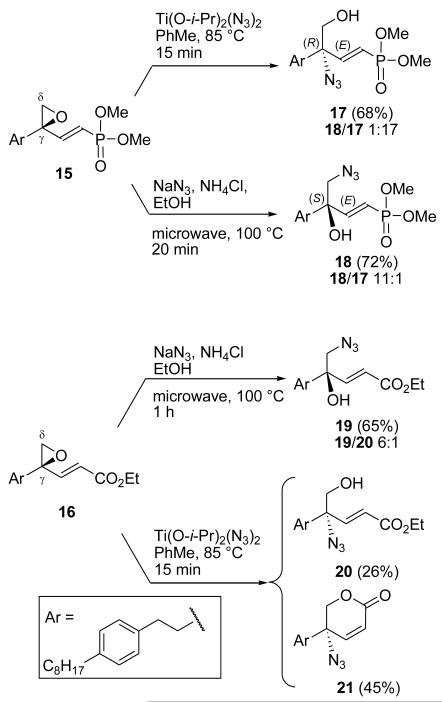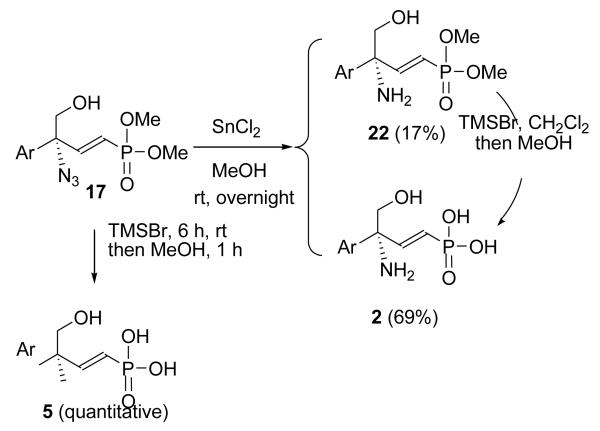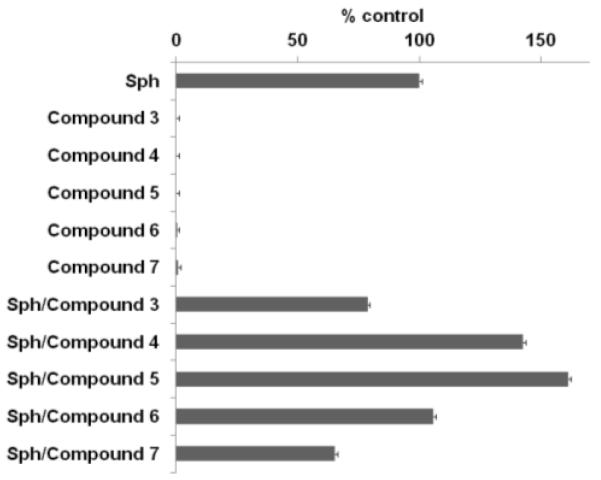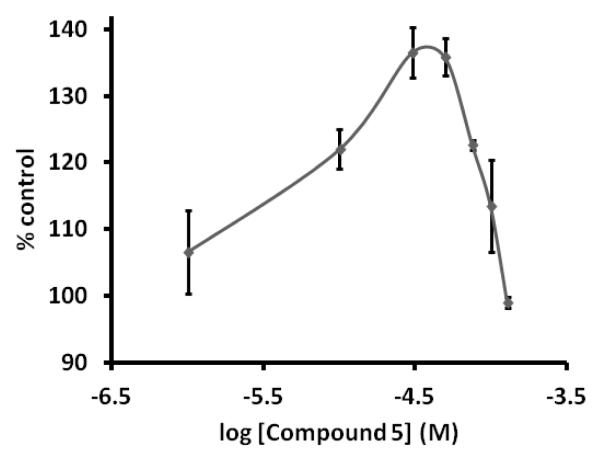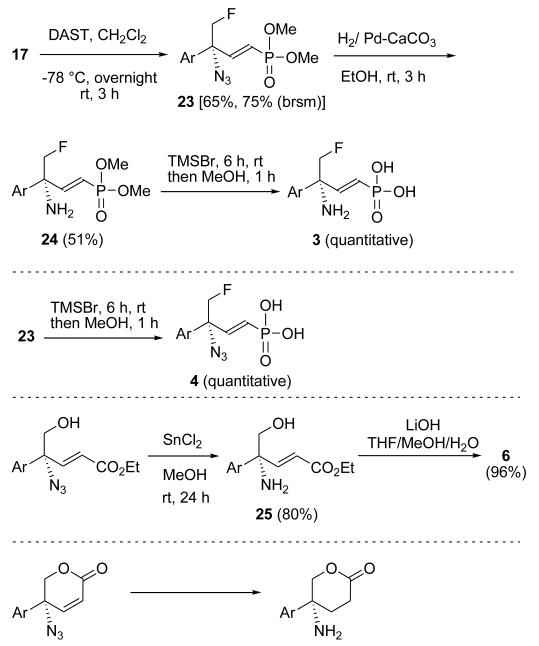Abstract
Sphingosine kinase 1 (SK1) is over-expressed in many cancers where it provides a selective growth and survival advantage to these cells. SK1 is thus a target for anti-cancer agents that can promote apoptosis of cancer cells. In previous work, we synthesized a novel allosteric SK1 inhibitor, (S)-FTY720 vinylphosphonate. We now report a more expeditious route to this inhibitor which features B-alkyl Suzuki coupling as a key step and show that replacement of the amino group in (S)-FTY720 vinylphosphonate with an azido group converts the vinylphosphonate from an allosteric inhibitor to an activator of SK1 at low micromolar concentrations. Our results demonstrate the feasibility of using the (S)-FTY720 vinylphosphonate scaffold to define structure-activity relationships in the allosteric site of SK1.
Keywords: Sphingosine 1-phosphate, B-alkyl Suzuki cross-coupling, FTY720, Epoxide opening, Allosterism
1. Introduction
Sphingosine kinase 1 (SK1) is over-expressed in various human cancers and therefore inhibitors of SK1 are potential anticancer agents.1 FTY720 (1, also known as fingolimod and by the trademark name Gilenya, Fig. 1) is a structural analogue of sphingosine that affects the activities of many sphingolipid-metabolizing enzymes in its non-phosphorylated form.2 On phosphorylation by sphingosine kinase 2 (SK2), FTY720 is converted into the immunomodulator (S)-FTY720-phosphate, which is the first compound in a new class of small molecule sphingosine 1-phosphate (S1P) receptor agonists that alters lymphocyte trafficking.3 In 2010, 1 was approved as an orally deliverable drug for the treatment of multiple sclerosis.4 The finding that non-phosphorylated 1 inhibited SK1 and SK2 led to interest in synthetic analogues of 1 as putative antitumor agents.5 Indeed, we reported that (S)-FTY720 vinylphosphonate (2),6 a metabolically stabilized derivative of 1, is an uncompetitive inhibitor (with sphingosine) and a mixed inhibitor (with ATP) of SK1.7,8 This mode of inhibition is indicative of allosterism contingent on formation of the sphingosine-SK1 complex, which offers new drug discovery opportunities and also permits further assessment of the role of SK1 in cancer.1
Figure 1.
FTY720 and analogues 2-7.
To gain further insight into the structure-activity relationships in 2 that result in binding at allosteric site(s) in SK1 we have prepared analogues 3-7 and evaluated their ability to modulate SK1 activity. We focused on modifying the polar head group while retaining the lipid tail of 2 as follows: (a) changing the hydroxyl group to a fluorine atom, (b) converting the amino group to an azide group, (c) replacing the vinyl-phosphonate moiety with a vinyl-carboxylic acid, and (d) limiting the conformational freedom in the polar head group by installing a lactone ring. The synthesis of chiral analogues 3-7 involves a B-alkyl Suzuki cross-coupling reaction as the key step. The route reported here is more efficient and practical than the previous synthetic route to 2.5
2. Chemistry
The challenge in the synthesis of 2 and analogues 3-7 lies in the construction of the sole quaternary stereocenter. Given the high yield and stereoselectivity in our previous synthesis,5 we decided to continue to employ Sharpless asymmetric epoxidation (SAE)9 of allylic alcohol 12 to introduce the stereocenter. Our new synthetic route to allylic alcohol 12 started with Wittig methylenation of the commercially available aldehyde 8 (Scheme 1). The resulting terminal alkene 9 was subjected to a B-alkyl Suzuki cross-coupling reaction10 with (2-iodoallyloxy)(tert-butyl)dimethylsilane (10),11 followed by removal of the TBS group in 11. Thus 12 was prepared in 66% yield (over four steps), with only one purification step (by column chromatography).
Scheme 1.
Synthesis of 14.
The scale used in this four-step procedure was up to 20 mmol. It is noteworthy that after the hydroboration of 9 with 9-BBN, the reaction mixture must be mixed with aqueous basic solution for at least 30 min prior to the addition of the palladium catalyst. The yield of 11 was markedly decreased when an aqueous NaOH solution and Pd(dppf)Cl2·CH2Cl2 were added simultaneously. In addition, ethanolamine12 did not completely precipitate the boron complex; we found that the rest of the complex was removed with H2O2/NaOH solution.13
For SAE of 12 on a scale of 13 mmol, a substoichiometric amount of catalyst [0.55 equiv. of Ti(O-i-Pr)4] was used, leading to epoxy alcohol 13 in 74% yield and 11% of a side product14 formed via epoxide opening by isopropoxide. It was reported by Sharpless and coworkers15 that the catalytic procedure [10 mol % of Ti(O-i-Pr)4] can prevent the epoxide-opening reaction for unsymmetrical-disubstituted allylic alcohols. The er value of the resulting epoxide was >20:1, as determined by analysis of the 1H NMR spectra of the (R)- and (S)-MTPA derivatives of 13. Dess-Martin oxidation of epoxy alcohol 13 proceeded in 90% yield.
Horner-Wadsworth-Emmons (HWE) olefination of aldehyde 14 with tetramethyl methylenediphosphonate afforded exclusively E-alkene 15 in 94% yield (Scheme 2). In contrast, poor E selectivity (16a: E/Z 3:1)16 was observed when 14 was treated with triethyl phosphonoacetate in H2O/iPrOH (1:1).17 However, the use of the sterically larger diisopropyl (ethoxycarbonylmethyl)phosphonate in the HWE reaction, as expected,18 provided excellent E selectivity (16: E/Z 25:1).
Scheme 2.
Synthesis of 15 and 16 via HWE reaction.
Since opening of a vinyl epoxide with an azide generally generates an allylic azide when no additional stabilizing group is present, a [3,3]-sigmatropic equilibration process takes place to create a mixture of regioisomers. Therefore, this reaction is of little value,19 and only a few systematic studies on ring-opening reactions of vinyl epoxides by azide ion have been published.19-23 We achieved regioselective epoxide ring openings of γ,δ-epoxy-α,β-unsaturated esters 15 and 16 with Ti(O-i-Pr)2(N3)2 and NaN3/NH4Cl, which permitted structural diversification of 2. With γ,δ-epoxy-α,β-unsaturated esters, nucleophilic attack at the γ position has been shown to predominate.20-24 As shown in Scheme 3, we employed two different azide sources. Surprisingly, as shown in Scheme 3, we found that azidolysis of 15 and 16 with NaN3/NH4Cl in EtOH25 afforded the highly δ-selective regioisomers 17 (68% yield) and 19 (72% yield), respectively. The ratio of regioisomers was determined by analysis of the 31P NMR spectra. On the other hand, the desired and expected regioisomer 17 (γ-attack) was obtained by treatment of 15 with Ti(O-i-Pr)2(N3)2 (which was prepared from Ti(O-i-Pr)4 and TMSN3).26
Scheme 3.
Opening of epoxide 15 and 16.
To our surprise, the reaction of 16 and Ti(O-i-Pr)2(N3)2 (3.9 equiv.) in toluene afforded 20 (26% yield), accompanied by lactone 21 (45% yield). The regioisomer 19 was not detected. The Z configuration of alkene 21 was confirmed by the 1H NMR spectrum, which shows correlated two doublets (δ 6.20 ppm, J = 9.8 Hz, =CHCO2Et; δ 6.75 ppm, J = 9.8 Hz, RCHCH=). Since δ-lactone formation from δ-hydroxy-trans-α,β-unsaturated carboxylic acids can be achieved via a pyridine-assisted trans-cis isomerization,27-30 it appears that azide anion might play a similar role as pyridine in our reaction.
Reduction of an azide to an amine in the presence of a double bond is not trivial. Both Staudinger reduction (Ph3P, THF/H2O) and 1,3-propanedithiol/Et3N31 failed to produce satisfactory results. Reduction using Lindlar’s catalyst (H2, Pd/CaCO3, EtOH)32 resulted in saturation of the double bond. Fortunately, as illustrated in Scheme 4, we found that simultaneous reduction of the azide and demethylation of methyl ester 17 was accomplished by using SnCl2in 95% MeOH,33 providing 2 in 69% yield, together with 22 (17% yield). Methyl ester 22 was transformed to 2 by treatment with TMSBr in quantitative yield. Our new synthetic route to 2 consists of nine steps from commercially available aldehyde 8 in 19% overall yield. The azide analogue 5 was formed by demethylation of 17 with TMSBr, followed by aqueous MeOH, in a quantitative yield. The stereochemistry of 22 was confirmed by its specific rotation: [α]25D +20.0 (c 0.18, CHCl3) [lit.5 [α]25D +18.8 (c 1.52, CHCl3)].
Scheme 4.
Synthesis of 2 and 5.
Fluorination of 17 with DAST34 (−78 °C, overnight, and then at rt for 3 h) produced 23 in 75% yield (Scheme 4). Termination of the reaction at low temperature led to incomplete conversion. In contrast to 17, reduction of 23 using Lindlar’s catalyst (H2, Pd/CaCO3, EtOH)32 did not reduce the double bond, providing 24 in 51% yield. Demethylation of methyl esters 23 and 24 with TMSBr followed by 95% MeOH afforded the target fluorine-containing analogues 4 and 3, respectively, in quantitative yields. The unsaturated carboxylic acid analogue 6 was prepared by reduction of 20 (SnCl2 in MeOH), followed by hydrolysis of ester 25 with LiOH in THF/MeOH/H2O. Catalytic hydrogenation of 21 (H2, Pd/C) provided lactone analogue 7 in 46% yield.
3. Biological evaluation
We have previously shown that (S)-vinylphosphonate 2 (50 μM) inhibits SK1 activity by 62.7 +/− 0.9 % (n = 3) using 3 μM sphingosine (Sph) as the substrate. (S)-FTY720 vinylphosphonate (2) is an uncompetitive inhibitor (with sphingosine) of SK1 with a Kiu = 14.5 +/− 4..4 μM.7 (S)-Vinylphosphonate 2 was not a substrate for SK1 (data not shown). We now show that analogues 3-7 have markedly different effects on SK1 activity (Fig. 2). We found that compounds 3-7 are not substrates, since no phosphorylated product was formed when Sph was omitted from the assay. In the presence of Sph, fluoride 3 is a weak inhibitor of SK1 (20% inhibition), while vinyl-carboxylate 6 is ineffective (Fig. 2), indicating that replacement of the –P(O)(OH)2 group with –CO2H (which retains a negative charge at this position of the molecule) eliminates inhibition. Indeed, we have shown that (S)-vinylphosphonate 2 is a mixed inhibitor (with ATP) of SK1, contingent on formation of the ATP-SK1 complex.8 The enzyme kinetics data for binding of 2 to the allosteric site, after ATP binds first to the active site, are uncompetitive with ATP, Kiu = 65.0 +/− 5.0 μM, and competitive with ATP, Kic = 10.0 +/− 4.6 μM. We proposed a ‘see-saw’ model for the binding of 2 to the ATP binding site and to the allosteric site.8 In this model, compound 2 competes with ATP for the ATP-binding site, but flips to bind to an allosteric site when ATP binds to the catalytic site.8 Therefore, the –P(O)(OH)2 group appears to be essential for binding of compound 2 to both the catalytic and allosteric sites. Amino lactone 7 is also an inhibitor of SK1 (35% inhibition) (Fig. 2). Replacement of the amino group with an azide group in compound 2 produced compounds 4 and 5; surprisingly, azido-fluoride 4 and azido-alcohol 5 are activators of SK1 at low micromolar concentrations (and they could not replace sphingosine as a substrate) (Fig. 2). Compounds 4 and 5 both induced a 30-60% stimulation of SK1 activity at low concentrations. The difference in these azide-containing compounds concern fluorine in compound 4, which can only accept hydrogen bonds, and a hydroxyl group in compound 5, which can both accept and donate hydrogen bonds.
Figure 2. Effects of compounds 3-7 on SK1 activity.
Substrates were 3 μM sphingosine (which corresponds to the Km of SK1)7 and 250 μM ATP (n = 3, results expressed as mean inhibition +/− S.E.). Compounds 2-7 were not substrates for SK1 and were each used at 50 μM. The SK1-selective inhibitor BML-25835 (50 μM) inhibited SK1 activity by 74.5 +/− 3.3 % (n = 3). Sph denotes sphingosine. The control is set at 100% and represents the SK1 activity against sphingosine alone.
At concentrations below 50 μM, compound 5 stimulated SK1 activity with an EC50 of 8.3 +/− 3.0 μM, n = 3 (Fig. 3), indicative of binding to an allosteric site. At concentrations above 50 μM, the % activation in response to compound 5 diminished markedly (Fig. 3). This biphasic response suggests that compound 5 might bind to the catalytic site (or alter its conformation) to inhibit SK1 activity at these higher concentrations. Similar results were obtained with compound 4 (EC50 of 5.7 +/− 5.5 μM, n = 3, data not shown). The biphasic curves found with both 4 and 5 indicate that the azido group and not the fluoro or hydroxyl group is responsible for this phenomenon.
Figure 3.
Concentration response of compound 5 on SK1 activity. Substrates were 3 μM sphingosine and 250 μM ATP (n = 3, results expressed as mean inhibition +/− S.E.). The control is set at 100% and represents the SK1 activity against sphingosine alone.
4. Conclusion
We have previously demonstrated that SK1 contains an allosteric site which binds both inhibitors and activators. This is based on three observations.7 First, compound 2 inhibited SK1 activity with kinetics indicative of an allosteric interaction. Second, two novel compounds, Bodipy-sphingosine and a regioisomer of FTY720, activated SK1 activity. Third, titration of an inactive SK1 mutant into cells expressing wild-type SK1 inhibited wild-type SK1 activity in a concentration-dependent manner. These findings are explained by a model in which SK1 is a minimal dimer, and that formation of the wild-type SK1-inactive SK1 mutant dimer produces an enzyme in which the number of allosteric sites exceed the competent catalytic site. Suppression of catalytic activity by an excess of allosteric sites suggests that this site might constitute an inhibitory domain. We proposed that SK1 contains an auto-inhibitory domain which exists in an ‘on’ and ‘off’ state in equilibrium.7 The ‘on’ state is stabilized by allosteric inhibitors to further suppress catalytic activity. Conversely, the ‘off’ state is stabilized by allosteric activators to remove the effect of the inhibitory domain on catalytic activity.7 These findings can be adapted to an induced-fit model. In the current study we show that the replacement of the amino group with an azido group in (S)-FTY720 vinylphosphonate (2) remarkably changed the compound from an inhibitor to an activator of SK1. That such a relatively minor chemical modification in compound 2 affects the nature of allosterism is entirely consistent with the notion that small changes in the chemical nature of a compound can be translated into subtle changes in the conformational state of the allosteric site. These conformational changes result in profound changes, as evidenced by turning an allosteric inhibitor into a compound that enhances enzymatic activity at low micromolar concentrations of compound. Our results also clearly demonstrate the feasibility of using the (S)-FTY720 vinylphosphonate scaffold to define the structure-activity relationships of the allosteric site in SK1.
5. Experimental section
5.1. Chemistry
5.1.1. General experimental information
All reactions were carried out under a dry N2 atmosphere using oven-dried glassware and magnetic stirring. The solvents were dried before use as follows: THF and Et2O were heated at reflux over sodium benzophenone ketyl; toluene was heated at reflux over sodium; CH2Cl2 was dried over CaH2. Anhydrous N,N-diisopropylethylamine, acetonitrile, triethylamine, and benzene were used directly as purchased. Aluminum TLC sheets (silica gel 60 F254) of 0.2-mm thickness were used to monitor the reactions. The spots were visualized with short wavelength UV light or by charring after spraying with a solution prepared from one of the following solutions: phosphomolybdic acid (5.0 g) in 95% EtOH (100 mL); p-anisaldehyde solution (2.5 mL of p-anisaldehyde, 2 mL of AcOH, and 3.5 mL of conc. H2SO4 in 100 mL of 95% EtOH); or KMnO4 solution (1.5 g of KMnO4 and 1.5 g of K2CO3 in 100 mL of 0.1% NaOH). Flash chromatography was carried out with silica gel 60 (230-400 ASTM mesh). NMR spectra were obtained on a 400-MHz or 500-MHz spectrometer. Chemical shifts were referenced on residual solvent peaks: CDCl3 (δ = 7.26 ppm for 1H NMR and 77.00 ppm for 13C NMR); external 85% H3PO4 (δ 0.00) was used for 31P NMR and CFCl3 (δ 0.00) for 19F NMR. Optical rotations were measured at rt in a 1.0-dm cell. High-resolution mass spectra were acquired by electrospray ionization.
5.1.2. Preparation of 1-octyl-4-vinylbenzene(9)
To a stirred suspension of Ph3PCH3Br (22.3 g, 62.4 mmol) in anhydrous THF (350 mL) was added n-BuLi (25 mL, 2.5 M in hexane, 62.5 mmol) dropwise at −78 °C. The mixture was stirred for 3 h at −78 °C. A solution of aldehyde 8 (6.80 g, 31.2 mmol) in 20 mL of THF was added slowly. The cooling bath was removed after the addition, and the reaction mixture was stirred for 2 h, during which time the temperature was increased slowly from −78 °C to rt. After 700 mL of hexane was added, the mixture was passed through a pressed pad of silica gel, which was rinsed with hexane/Et2O (10:1). The filtrate was concentrated under reduced pressure to provide the pure alkene 9 (6.34 g, 94%). 1H NMR (500 MHz, CDCl3) δ 0.83-0.92 (m, 3H), 1.22-1.41 (m, 10H), 1.56-1.67 (m, 2H), 2.55-2.65 (m, 2H), 5.18-5.23 (m, 1H), 5.69-5.76 (m, 1H), 6.67-6.76 (m, 1H), 7.14-7.19 (m, 2H), 7.32-7.38 (m, 2H); 13C NMR (125 MHz, CDCl3) δ 14.1, 22.7, 29.26, 29.30, 29.5, 31.5, 31.9, 35.7, 112.7, 126.1, 128.5, 135.0, 136.7, 142.7.
5.1.3. Preparation of 2-methylene-4-(4-octylphenyl)butan-1-ol (12)
A solution of alkene 9 (4.14 g, 19.1 mmol) in THF (15 mL) was added dropwise to a solution of 9-BBN (200 mL, 0.5 M in THF, 100 mmol) at 0 °C. The reaction mixture was allowed to warm to rt. After 1 h at rt, the mixture was cooled to 0 °C and 3 M aqueous NaOH (210 mmol, 70 mL) was added. The mixture was stirred vigorously for 1 h at rt, and then was added to a suspension of (2-iodoallyloxy)(tert-butyl)dimethylsilane10 (6.35 g, 21.3 mmol) and Pd(dppf)Cl2·CH2Cl2 (570 mg, 0.70 mmol) in THF (50 mL). The reaction mixture was stirred at 60 °C for 3 h. After cooling to rt, the mixture was added to ethanolamine (12 mL) to precipitate the 9-BBN/ethanolamine complex. The mixture was stirred overnight at rt, poured into saturated aqueous NH4Cl solution, and extracted with Et2O. The combined organic extracts were concentrated under reduced pressure and suspended in hexane/Et2O (100 mL, 10:1). The mixture was filtered through a short pad of silica gel, which was washed with hexane/Et2O (10:1). The filtrate was concentrated under reduced pressure to provide the crude coupling product.
To a solution of crude coupling product in MeOH (200 mL) was added 6 M HCl (100 μL, 0.6 mmol). After being stirred at rt for 1 h, the reaction mixture was quenched by slowly adding saturated aqueous NaHCO3 solution. MeOH was removed under reduced pressure, and the aqueous phase was extracted with Et2O. In order to completely remove the boron complex, the combined organic extracts were treated with 100 mL of 15% NaOH, followed by dropwise addition of 30% H2O2 (50 mL). The mixture was stirred at rt for 0.5 h. The aqueous phase was extracted with Et2O, and the combined organic phases were dried (MgSO4) and concentrated under reduced pressure. The residue was purified by flash chromatography (hexane/EtOAc 8:1, 6:1, to 4:1) to afford 3.67 g (70%) of 12. The 1H and 13C NMR spectra of 12 matched the reported data.5 ESI-HRMS (M+Na)+ calcd for C19H30NaO+ 297.2189, found 297.2193.
5.1.4. Preparation of (S)-2-(4-octylphenethyl)oxirane-2-carbaldehyde(14)
Dess-Martin periodinane (3.18 g, 7.50 mmol) was added portionwise to a solution of alcohol 13 (1.45 g, 85% purity, 4.24 mmol,) in 4 mL of pyridine and 50 mL of CH2Cl2. After 2 h, the reaction mixture was diluted with Et2O (100 mL), and saturated aqueous NaHCO3 solution (20 mL) and saturated aqueous Na2S2O3 (20 mL) were added to the reaction mixture. After vigorous stirring for 10 min, the mixture was extracted with Et2O. The combined organic layers were washed with saturated aqueous NaHCO3 solution, dried (MgSO4), and filtered. The solvent was removed under reduced pressure, and the residue was purified by flash chromatography on silica gel (EtOAc/hexane 1:10, 1:8, to 1:6) to afford 1.1 g (90%) of aldehyde 14. 1H NMR (500 MHz, CDCl3) δ 0.83-0.92 (m, 3H), 1.22-1.36 (m, 10H), 1.56-1.64 (m, 2H), 2.01-2.08 (m, 1H), 2.20-2.28 (m, 1H), 2.58 (t, J = 7.8 Hz, 2H), 2.72 (t, J = 8.2 Hz, 2H), 2.99 (d, J = 4.6 Hz, 1H), 3.04 (d, J = 4.6 Hz, 1H), 7.10-7.13 (m, 4H), 8.89 (s, 1H); 13C NMR (125 MHz, CDCl3) δ 14.1, 22.6, 29.2, 29.3, 29.5, 29.9, 30.2, 31.5, 31.9, 35.5, 49.8, 60.9, 128.1, 128.5, 138.0, 140.8, 198.8; ESI-HRMS (M+Na)+ calcd for C19H28NaO2+ 311.1982, found 311.1986.
5.1.5. Preparation of (E)-dimethyl 2-[(R)-2-(4-octylphenethyl)oxiran-2-yl]vinylphosphonate (15)
To a mixture of NaH (57-63% oil dispersion, 240 mg, 6.00 mmol) and 50 mL of THF was added a solution of 1.41 g (6.08 mmol) of CH2[(P(O)(OMe)2] in 10 mL of THF at 0 °C. After the mixture was stirred for 30 min, a solution of 14 (585 mg, 2.03 mmol) in 10 mL of THF was added. The reaction mixture was stirred for 1 h at 0 °C, quenched with saturated aqueous NH4Cl solution, and extracted with EtOAc. The organic layer was dried (MgSO4) and concentrated under reduced pressure. The residue was purified by chromatography (elution with EtOAc) to give 750 mg (94%) of 15. 1H NMR (400 MHz, CDCl3) δ 0.83-0.92 (m, 3H), 1.20-1.38 (m, 10H), 1.53-1.64 (m, 2H), 1.90-2.01 (m, 1H), 2.08-2.18 (m, 1H), 2.53-2.59 (m, 2H), 2.62-2.77 (m, 3H), 2.87 (t, J = 5.4 Hz, 1H), 3.72 (d, J = 5.5 Hz, 3H), 3.74 (d, J = 5.5 Hz, 3H), 5.95 (dd, J = 17.2, 19.4 Hz, 1H), 6.83 (dd, J = 17.2, 22.2 Hz, 1H), 7.05-7.13 (m, 4H); 13C NMR (100 MHz, CDCl3) δ 14.1, 22.6, 29.2, 29.3, 29.4, 30.6, 31.5, 31.8, 35.2, 35.5, 52.38 (d, J = 5.4 Hz), 52.41 (d, J = 5.4 Hz), 55.9, 58.2 (d, J = 24.0 Hz), 116.5 (d, J = 189.6 Hz), 128.0, 128.5, 137.9, 140.8, 151.6 (d, J = 6.5 Hz); 31P NMR (162 MHz, CDCl3) δ 20.6; ESI-HRMS (M+H)+ calcd for C22H36O4P+ 395.2346, found 395.2346.
5.1.6. Preparation of (E)-ethyl 3-[(R)-2-(4-octylphenethyl)oxiran-2-yl]acrylate (16)
K2CO3 (4.51 g, 32.6 mmol) was dissolved in water (10 mL), and the solution was cooled to rt. This aqueous solution was then added to a solution of aldehyde 14 (350 mg, 1.21 mmol) and (i-PrO)2P(O)CH2CO2Et (866 μL, 3.64 mmol) in 2-propanol (10 mL) at 0 °C. The reaction mixture was allowed to warm to rt and was stirred overnight at rt. The reaction mixture was separated and the lower aqueous layer was extracted with EtOAc. The combined organic layers were dried (Na2SO4), filtered, and concentrated under reduced pressure. The residue was purified by flash chromatography (hexane/EtOAc 3:1) to give 409 mg (94%) of 16. 1H NMR (500 MHz, CDCl3) δ 0.83-0.92 (m, 3H), 1.20-1.36 (m, 13H), 1.54-1.63 (m, 2H), 1.93-2.01 (m, 1H), 2.09-2.16 (m, 1H), 2.57 (t, J = 7.7 Hz, 2H), 2.65-2.75 (m, 3H), 2.88 (d, J = 5.4 Hz, 1H), 4.21 (q, J = 7.1 Hz, 2H), 6.10 (d, J = 15.7 Hz, 1H), 6.91 (d, J = 15.7 Hz, 1H), 7.06-7.12 (m, 4H); 13C NMR (100 MHz, CDCl3) δ 14.1, 14.2, 22.6, 29.2, 29.3, 29.5, 30.7, 31.5, 31.9, 35.45, 35.52, 55.8, 57.6, 60.6, 122.2, 128.1, 128.5, 138.1, 140.8, 146.6, 166.0; ESI-HRMS (M+Na)+ calcd for C23H34NaO3+ 381.2400, found 381.2401.
5.1.7. Preparation of (S,E)-dimethyl 3-azido-3-(hydroxymethyl)-5-(4-octylphenyl)pent-1-enylphosphonate (17)
Ti(O-i-Pr)4 (2.4 mL, 8.02 mmol) and TMSN3 (2.2 mL, 16.6 mmol) were added to anhydrous toluene (50 mL), and the mixture was heated at reflux (85 °C) under N2 for at least 5 h. A solution of epoxide 15 (670 mg, 1.70 mmol) in anhydrous toluene (10 mL) was added to the above solution in one portion. The mixture was stirred for 15 min at 85 °C and was then cooled to rt. The solvent was removed under reduced pressure. Et2O (20 mL) was added, followed by 10% HCl (40 mL). The solution was stirred at rt until two clear phases appeared. The aqueous phase was extracted with Et2O. The organic phase was dried over MgSO4, filtered, and concentrated under reduced pressure. Purification by flash chromatography (elution with EtOAc) afforded 17 (500 mg, 68%) as a yellow oil. 1H NMR (500 MHz, CDCl3) δ 0.83-0.92 (m, 3H), 1.20-1.36 (m, 10H), 1.54-1.62 (m, 2H), 1.90-1.99 (m, 1H), 2.03-2.11 (m, 1H), 2.51-2.67 (m, 4H), 3.01 (s, 1H, OH), 3.70-3.80 (m, 8H), 6.03 (dd, J = 17.1, 19.3 Hz, 1H), 6.72 (dd, J = 17.2, 22.7 Hz, 1H), 7.06-7.12 (m, 4H); 13C NMR (100 MHz, CDCl3) δ 14.1, 22.6, 29.2, 29.3, 29.46, 29.50, 31.6, 31.9, 35.5, 36.0, 52.53 (d, J = 5.5 Hz), 52.55 (d, J = 5.5 Hz), 67.4, 69.0 (d, J = 19.4 Hz), 118.1 (d, J = 186.9 Hz), 128.1, 128.6, 137.9, 140.9, 151.0 (d, J = 6.3 Hz); 31P NMR (162 MHz, CDCl3) δ 20.5; ESI-HRMS (M+H)+ calcd for C22H36N3O4P+ 438.2516, found 438.2519.
5.1.8. Preparation of (R,E)-dimethyl 3-(azidomethyl)-3-hydroxy-5-(4-octylphenyl)pent-1-enylphosphonate (18)
A mixture of 15 (45 mg, 0.114 mmol), NaN3 (37 mg, 0.569 mmol), and NH4Cl (49 mg, 0.916 mmol) in EtOH (2 mL) was heated at 100 °C via microwave radiation for 20 min. The reaction mixture was allowed to cool to rt and was then filtered through a thin pad of Celite (eluting with EtOAc), and the filtrate was concentrated under reduced pressure. The crude material was purified by flash chromatography (elution with EtOAc) on silica gel to provide azide 18 (36 mg, 72%). 1H NMR (400 MHz, CDCl3) δ 0.83-0.92 (m, 3H), 1.20-1.36 (m, 10H), 1.52-1.62 (m, 2H), 1.80-1.90 (m, 1H), 1.92-2.02 (m, 1H), 2.48-2.59 (m, 3H), 2.62-2.72 (m, 1H), 3.13 (s, 1H, OH), 3.39 (s, 2H), 3.74 (dd, J = 2.4, 11.1 Hz, 6H), 6.10 (dd, J = 17.1, 20.3 Hz, 1H), 6.78 (dd, J = 17.1, 22.3 Hz, 1H), 7.04-7.12 (m, 4H); 13C NMR (100 MHz, CDCl3) δ 14.1, 22.6, 29.0, 29.2, 29.3, 29.4, 31.5, 31.8, 35.5, 39.3, 52.46 (d, J = 5.6 Hz), 52.49 (d, J = 5.6 Hz), 59.1, 76.0 (d, J = 19.2 Hz), 116.6 (d, J = 187.8 Hz), 128.1, 128.5, 138.2, 140.8, 154.9 (d, J = 5.5 Hz); 31P NMR (162 MHz, CDCl3) δ 20.9; ESI-HRMS (M+Na)+ calcd for C22H36N3NaO4P+ 460.2336, found 460.2334.
5.1.9. Preparation of (R,E)-ethyl 4-(azidomethyl)-4-hydroxy-6-(4-octylphenyl)hex-2-enoate (19)
A mixture of 16 (47 mg, 0.131 mmol), NaN3 (26 mg, 0.400 mmol), and NH4Cl (21 mg, 0.40 mmol) in EtOH (2 mL) was heated at 100 °C via microwave radiation for 1 h. The reaction mixture was allowed to cool to rt and was then filtered through a thin pad of Celite (eluting with EtOAc), and the filtrate was concentrated under reduced pressure. The crude material was purified by flash chromatography (hexane/EtOAc 20:1, 10:1, to 8:1) on silica gel to provide azide 19 (34 mg, 65%). 1H NMR (400 MHz, CDCl3) δ 0.83-0.92 (m, 3H), 1.20-1.36 (m, 13H), 1.52-1.63 (m, 2H), 1.82-1.92 (m, 1H), 1.93-2.03 (m, 1H), 2.50-2.60 (m, 3H), 2.61-2.71 (m, 1H), 3.37-3.45 (m, 2H), 4.23 (q, J = 7.1 Hz, 2H), 6.19 (d, J = 15.6 Hz, 1H), 6.90 (d, J = 15.6 Hz, 1H), 7.04-7.12 (m, 4H); 13C NMR (100 MHz, CDCl3) δ 14.1, 14.2, 22.6, 29.1, 29.2, 29.3, 29.4, 31.5, 31.9, 35.5, 39.5, 59.5, 60.7, 75.4, 122.3, 128.1, 128.6, 138.2, 140.8, 149.1, 166.1; ESI-HRMS (M+Na)+ calcd for C23H35N3NaO3+ 424.2571, found 424.2573.
5.1.10. Preparation of (S,E)-ethyl 4-azido-4-(hydroxymethyl)-6-(4-octylphenyl)hex-2-enoate (20) and (S)-5-(4-octylphenethyl)-5-azido-5,6-dihydropyran-2-one (21)
Ti(O-i-Pr)4 (400 mg, 1.40 mmol) and TMSN3 (394 μL, 3.00 mmol) were added to anhydrous toluene (10 mL), and the mixture was heated at reflux at 75 °C under N2 overnight. A solution of epoxide 16 (129 mg, 0.36 mmol) in anhydrous toluene (5 mL) was added to the above solution in one portion. The mixture was stirred for 15 min at 85 °C and was cooled to rt. The solvent was removed under reduced pressure. Et2O (20 mL) was added, followed by 10% HCl (10 mL). The solution was stirred at rt until two clear phases appeared. The aqueous phase was extracted with Et2O. The organic phase was dried over MgSO4, filtered, and concentrated under reduced pressure. Purification of the residue by flash chromatography (elution with hexane/EtOAc, 10:1, 6:1, 5:1, to 4:1) afforded 21 (58 mg, 45%) and 20 (37 mg, 26%). Data of 20: 1H NMR (400 MHz, CDCl3) δ 0.83-0.92 (m, 3H), 1.20-1.36 (m, 13H), 1.52-1.63 (m, 2H), 1.92-2.01 (m, 1H), 2.03-2.13 (m, 1H), 2.53-2.70 (m, 4H), 3.69-3.78 (m, 2H), 4.22 (q, J = 7.1 Hz, 2H), 6.16 (d, J = 15.7 Hz, 1H), 6.84 (d, J = 15.7 Hz, 1H), 7.04-7.12 (m, 4H); 13C NMR (100 MHz, CDCl3) δ 14.1, 14.2, 22.6, 29.2, 29.3, 29.4, 29.5, 31.5, 31.9, 35.5, 36.3, 60.9, 67.5, 68.0, 123.6, 128.1, 128.6, 137.9, 140.9, 145.1, 165.9; ESI-HRMS (M+Na)+ calcd for C23H35N3NaO3+ 424.2571, found 424.2570. Data of 21: 1H NMR (400 MHz, CDCl3) δ 0.83-0.92 (m, 3H), 1.20-1.36 (m, 10H), 1.53-1.63 (m, 2H), 1.86-2.04 (m, 2H), 2.53-2.59 (m, 2H), 2.62-2.78 (m, 2H), 4.34-4.46 (m, 2H), 6.20 (d, J = 9.8 Hz, 1H), 6.75 (d, J = 9.8 Hz, 1H), 7.04-7.13 (m, 4H); 13C NMR (100 MHz, CDCl3) δ 14.1, 22.6, 29.0, 29.2, 29.3, 29.4, 31.5, 31.8, 35.5, 37.6, 58.7, 73.6, 122.6, 128.0, 128.7, 137.0, 141.2, 144.7, 161.6; ESI-HRMS (M+Na)+ calcd for C21H29N3NaO2+ 378.2152, found 378.2151.
5.1.11. Preparation of (S,E)-dimethyl 3-amino-3-(hydroxymethyl)-5-(4-octylphenyl)pent-1-enylphosphonate (22) and (S)-FTY720 vinylphosphonate (2)
To a solution of azide 17 (50 mg, 0.114 mmol) in 95% MeOH (3 mL) was added SnCl2 (85 mmol, 0.448 mmol) at rt. After the reaction mixture was stirred at rt overnight, the solvent was removed under reduced pressure. The residue was diluted with Et2O, and the mixture was neutralized with aqueous saturated NaHCO3 solution, followed by aqueous NaOH solution (15%). The aqueous layer was extracted with Et2O, and the combined organic layers were dried (K2CO3), filtered, and concentrated under reduced pressure. The residue was purified by flash chromatography (CHCl3/MeOH 20:1, CHCl3/MeOH/NH4OH 130:25:4, CHCl3/MeOH/AcOH 65:25:4) to give 8 mg (17%) of 22 and 30 mg (69%) of (S)-FTY720 vinylphosphonate (2). Data of 22: The 1H, 13C, and 31P NMR spectra of 22 matched the reported data;5 see the Supporting Information; [α]25D +20.0 (c 0.18, CHCl3) [lit.5 [α]25D +18.8 (c 1.52, CHCl3)]; ESI-HRMS (M+H)+ calcd for C22H40NO4P+ 414.2758, found 414.2769. Data of 2: 1H, 13C, and 31P NMR spectra of 2 matched the reported data;5 see the Supporting Information.
5.1.12. Preparation of (S,E)-3-azido-3-(hydroxymethyl)-5-(4-octylphenyl)pent-1-enylphosphonic acid (5)
To a solution of 17 (10 mg, 0.023 mmol) in 2 mL of dry CH2Cl2 at rt was added 30 μL (0.23 mmol) of TMSBr. After the reaction mixture had been stirred for 6 h, the solvent was removed, and the residue was dried and dissolved in 2 mL of 95% MeOH with stirring for 1 h. Removal of the solvent afforded 9 mg (100%) of 5. 1H NMR (500 MHz, CDCl3) δ 0.83-0.92 (m, 3H), 1.20-1.36 (m, 10H), 1.52-1.63 (m, 2H), 1.85-1.94 (m, 1H), 1.97-2.07 (m, 1H), 2.52-2.68 (m, 4H), 3.67-3.74 (m, 2H), 6.09-6.22 (m, 1H), 6.45-6.59 (m, 1H), 7.07-7.13 (m, 4H); 13C NMR (125 MHz, CDCl3) δ 13.7, 22.4, 28.98, 29.04, 29.1, 29.2, 29.4, 31.3, 31.6, 35.2, 36.0, 68.4 (d, J = 18.4 Hz), 127.8, 128.4, 138.1, 140.5, 146.7; 31P NMR (202 MHz, CDCl3) δ 15.5; ESI-HRMS (M+H)+ calcd for C22H33N3O4P+ 410.2203, found 410.2206.
5.1.13. Preparation of (S,E)-dimethyl 3-azido-3-(fluoromethyl)-5-(4-octylphenyl)pent-1-enylphosphonate (23)
To a solution of alcohol 17 (75 mg, 0.171 mmol) in anhydrous CH2Cl2 (1.0 mL) was added diethylaminosulfur trifluoride (DAST) (68 μL, 0.515 mmol) at −78 °C. The reaction mixture was stored at −78 °C overnight, and then was stirred at rt for 3 h. The mixture was poured into aqueous saturated NaHCO3 solution, the aqueous phase was extracted with CH2Cl2, and the combined CH2Cl2 layers were dried (Na2SO4), filtered, and concentrated under reduced pressure. Purification by flash chromatography (elution with PhMe/EtOAc, 1:1 to 100% EtOAc) afforded 23 (49 mg, 65%), along with 10 mg (13%) of recovered alcohol 17. 1H NMR (500 MHz, CDCl3) δ 0.83-0.92 (m, 3H), 1.20-1.36 (m, 10H), 1.53-1.63 (m, 2H), 1.88-2.02 (m, 1H), 2.12-2.22 (m, 1H), 2.51-2.60 (m, 3H), 2.64-2.72 (m, 1H), 3.34-3.53 (m, 2H), 3.77 (d, J = 11.1 Hz, 6H), 6.12 (dd, J = 17.1, 18.8, 1H), 6.73 (ddd, J = 17.1, 21.4, 22.8 Hz, 1H), 7.03-7.13 (m, 4H); 13C NMR (100 MHz, CDCl3) δ 14.1, 22.6, 28.6, 28.7, 29.2, 29.3, 29.4, 31.5, 31.9, 35.5, 37.4 (d, J = 21.9 Hz), 52.5 (t, J = 5.5 Hz), 56.5 (d, J = 23.9 Hz), 97.5 (dd, J = 19.6, 184.9 Hz), 118.0 (dd, J = 9.6, 187.8 Hz), 128.0, 128.6, 137.5, 141.0, 149.5 (dd, J = 5.8, 20.4 Hz); 31P NMR (162 MHz, CDCl3) δ 19.6; 19F NMR (376 MHz, CDCl3) δ −164.5; ESI-HRMS (M+H)+ calcd for C22H36FN3O3P+ 440.2473, found 440.2472.
5.1.14. Preparation of (S,E)-dimethyl 3-amino-3-(fluoromethyl)-5-(4-octylphenyl)pent-1-enylphosphonate (24)
A solution of azide 23 (40 mg, 0.091 mmol) in ethanol (2 mL) was treated with Lindlar’s catalyst (46 mg). The suspension was purged with H2 for approximately 10 min and then was stirred for 2 h under a balloon filled with H2. The crude reaction mixture was filtered through a short pad of Celite, washed with EtOAc, and concentrated. The residue was purified by flash chromatography (CHCl3/MeOH 20:1) to give 19 mg (51%) of 24. 1H NMR (500 MHz, CDCl3) δ 0.83-0.92 (m, 3H), 1.20-1.36 (m, 10H), 1.53-1.63 (m, 2H), 1.84-1.98 (m, 1H), 2.03-2.13 (m, 1H), 2.51-2.59 (m, 3H), 2.64-2.71 (m, 1H), 2.81-3.00 (m, 2H), 3.76 (dd, J = 3.5, 11.2 Hz, 6H), 6.05 (dd, J = 17.2, 19.9, 1H), 6.72 (ddd, J = 17.2, 22.0, 23.1 Hz, 1H), 7.04-7.12 (m, 4H); 13C NMR (100 MHz, CDCl3) δ 14.1, 22.6, 28.8, 28.9, 29.2, 29.3, 29.4, 31.5, 31.8, 35.5, 37.6 (d, J = 21.8 Hz), 48.9 (d, J = 25.0 Hz), 52.5 (d, J = 5.5 Hz), 98.6 (dd, J = 18.8, 180.9 Hz), 117.3 (dd, J = 9.6, 188.2 Hz), 128.0, 128.5, 138.0, 140.8, 151.5 (dd, J = 5.7, 20.9 Hz); 31P NMR (162 MHz, CDCl3) δ 20.3; 19F NMR (376 MHz, CDCl3) δ −170.3.
5.1.15. Preparation of (S,E)-3-amino-3-(fluoromethyl)-5-(4-octylphenyl)pent-1-enylphosphonic acid (3)
To a solution of 24 (19 mg, 0.046 mmol) in 2 mL of dry CH2Cl2 at rt was added 120 μL (0.92 mmol) of TMSBr. After the reaction mixture had been stirred for 6 h, the solvent was removed, and the residue was dried and dissolved in 2 mL of 95% MeOH with stirring for 1 h. Removal of the solvent afforded 18 mg (100%) of 3 as a white solid. 1H NMR (400 MHz, CDCl3/CD3OD/CD3CO2D 80:20:1) δ 0.83-0.92 (m, 3H), 1.20-1.36 (m, 10H), 1.50-1.63 (m, 2H), 1.97-2.16 (m, 2H), 2.50-2.73 (m, 4H), 3.25-3.48 (m, 2H), 6.26-6.43 (m, 1H), 6.46-6.68 (m, 1H), 7.03-7.12 (m, 4H); 13C NMR (125 MHz, CDCl3/CD3OD/CD3CO2D 80:20:1) δ 13.7, 22.3, 27.93, 27.96, 28.96, 29.03, 29.2, 31.3, 31.6, 35.2, 37.9 (d, J = 21.0 Hz), 45.1 (d, J = 22.4 Hz), 95.0 (dd, J = 183.4, 20.2 Hz),, 125.8 (d, J = 180.6 Hz), 127.7, 128.3, 137.1, 140.7, 142.4 (d, J = 20.5 Hz); 31P NMR (162 MHz, CDCl3/CD3OD/CD3CO2D 80:20:1) δ 13.3; 19F NMR (376 MHz, CDCl3/CD3OD/CD3CO2D 80:20:1) δ −167.7; ESI-HRMS (M+H)+ calcd for C20H34FNO3P+ 386.2255, found 386.2256.
5.1.16. Preparation of (S,E)-3-azido-3-(fluoromethyl)-5-(4-octylphenyl)pent-1-enylphosphonic acid (4)
To a solution of 23 (10 mg, 0.023 mmol) in 2 mL of dry CH2Cl2 at rt was added 30 μL (0.23 mmol) of TMSBr. After the reaction mixture had been stirred for 6 h, the solvent was removed, and the residue was dried and dissolved in 2 mL of 95% MeOH with stirring for 1 h. Removal of the solvent afforded 10 mg (100%) of 4 as a white solid. 1H NMR (400 MHz, CDCl3/CD3OD/CD3CO2D 80:20:1) δ 0.83-0.92 (m, 3H), 1.20-1.36 (m, 10H), 1.52-1.63 (m, 2H), 1.87-2.05 (m, 1H), 2.10-2.24 (m, 1H), 2.50-2.69 (m, 4H), 3.40-3.50 (m, 2H), 6.16-6.28 (m, 1H), 6.49-6.68 (m, 1H), 7.04-7.14 (m, 4H); 13C NMR (125 MHz, CDCl3/CD3OD/CD3CO2D 80:20:1) δ 13.7, 22.3, 28.3, 29.0, 29.2, 31.3, 31.6, 35.2, 37.1, 37.3, 56.3 (d, J = 24.4 Hz), 97.2 (d, J = 184.2 Hz), 127.8, 128.3, 137.7, 140.6, 145.2; 31P NMR (162 MHz, CDCl3/CD3OD/CD3CO2D 80:20:1) δ 15.2; ESI-HRMS (M+H)+ calcd for C20H32FNO3P+ 386.2255, found 386.2256.
5.1.17. Preparation of (S,E)-ethyl 4-amino-4-(hydroxymethyl)-6-(4-octylphenyl)hex-2-enoate (25)
To the solution of azide 20 (12 mg, 0.03 mmol) in anhydrous MeOH (1 mL) was added SnCl2 (27 mmol, 0.142 mmol) at rt. After the reaction mixture was stirred at rt for 24 h, the solvent was removed under reduced pressure. The residue was diluted with Et2O, and the mixture was neutralized with aqueous saturated NaHCO3 solution, followed by aqueous NaOH solution (15%). The aqueous layer was extracted with Et2O, and the combined organic layers were dried (MgSO4), filtered, and concentrated under reduced pressure. The residue was purified by flash chromatography (CHCl3/MeOH 40:1 to 20:1) to give 9 mg (80%) of 25. 1H NMR (500 MHz, CDCl3) δ 0.83-0.92 (m, 3H), 1.20-1.36 (m, 13H), 1.52-1.63 (m, 2H), 1.73-1.89 (m, 2H), 2.47-2.64 (m, 4H), 3.48-3.54 (m, 2H), 4.22 (q, J = 7.1 Hz, 2H), 6.04 (d, J = 15.9 Hz, 1H), 6.98 (d, J = 15.9 Hz, 1H), 7.05-7.11 (m, 4H); 13C NMR (100 MHz, CDCl3) δ 14.1, 14.2, 21.9, 22.7, 29.2, 29.3, 29.4, 29.5, 29.7, 31.5, 31.9, 35.5, 39.7, 58.2, 60.6, 69.0, 121.3, 128.1, 128.5, 138.6, 140.7, 152.2, 166.3; ESI-HRMS (M+H)+ calcd for C23H37NO3+ 376.2846, found 376.2849.
5.1.18. Preparation of (S,E)-4-amino-4-(hydroxymethyl)-6-(4-octylphenyl)hex-2-enoic acid (6)
To a solution of ester 25 (9 mg, 0.024 mmol) in THF/MeOH/H2O (1 mL/1 mL/0.5 mL) was added LiOH·H2O (20 mg, 0.48 mmol) at rt. The reaction mixture was stirred overnight at rt, and then was neutralized with 1 M HCl (5 mL). The mixture was separated and the aqueous layer was extracted with CH2Cl2. The combined organic layers were dried (Na2SO4), filtered, and concentrated under reduced pressure to provide 6 (8 mg, 96%) as a white solid. 1H NMR (500 MHz, CDCl3/CD3OD/CD3CO2D 80:20:1) δ 0.83-0.92 (m, 3H), 1.20-1.36 (m, 10H), 1.54-1.63 (m, 2H), 2.01-2.18 (m, 2H), 2.53-2.69 (m, 4H), 3.76-3.82 (m, 2H), 6.15 (d, J = 16.3 Hz, 1H), 6.89 (d, J = 16.3 Hz, 1H), 7.09-7.12 (m, 4H); 13C NMR (100 MHz, CDCl3/CD3OD/CD3CO2D 80:20:1) δ 13.7, 22.4, 28.6, 29.0, 29.1, 29.2, 29.5, 31.3, 31.7, 35.3, 36.1, 61.1, 64.0, 124.0, 127.8, 128.4, 136.9, 140.9, 143.4, 167.3; ESI-HRMS (M+H)+ calcd for C21H34NO3+ 348.2533, found 348.2536.
5.1.19. Preparation of (S)-5-(4-octylphenethyl)-5-amino-tetrahydropyran-2-one (7)
A solution of 21 (14 mg, 0.039 mmol) in EtOH (5 mL) was treated with Pd/C (14 mg, 10% w/w). The suspension was purged with H2 for approximately 10 min and then was stirred overnight at rt under a balloon filled with H2. The crude reaction mixture was filtered through a short pad of Celite, washed with CH2Cl2, and concentrated. The residue was purified by flash chromatography (CHCl3/MeOH 20:1 to 10:1) to give 6 mg (46%) of 7. 1H NMR (400 MHz, CDCl3) δ 0.83-0.92 (m, 3H), 1.20-1.36 (m, 10H), 1.53-1.63 (m, 2H), 1.80-1.90 (m, 2H), 1.90-2.09 (m, 2H), 2.34-2.51 (m, 2H), 2.51-2.64 (m, 4H), 3.50 (d, J = 11.3 Hz, 1H), 3.61 (d, J = 11.3 Hz, 1H), 7.04-7.13 (m, 4H); 13C NMR (100 MHz, CDCl3) δ 14.1, 22.6, 27.8, 29.3, 29.4, 29.5, 29.6, 30.8, 31.6, 31.9, 35.5, 38.8, 63.5, 68.3, 128.1, 128.5, 138.4, 140.7, 178.5; ESI-HRMS (M+Na)+ calcd for C21H31NNaO2+ 354.2404, found 354.2404.
5.2. Biology
5.2.1. Cell culture
HEK 293 cells stably over-expressing GFP-SK1 (30-fold increase in SK1 activity versus vector-transfected cells) were cultured in DMEM supplemented with 10% European fetal calf serum, 100 U/mL penicillin, 100 μg/mL streptomycin, 1% non-essential amino acids, and 0.8% geneticin at 37 °C in 5% CO2.
5.2.2. Sphingosine kinase 1 assay
Sphingosine was solubilized in Triton X-100 (final concentration, 0.063% w/v) and combined with 20 mM Tris (pH 7.4), 1 mM EDTA, 1 mM Na3VO4, 40 mM β-glycerophosphate, 1 mM NaF, 0.007% (v/v) β-mercaptoethanol, 20% (v/v) glycerol, 10 μg/mL aprotinin, 10 μg/mL soybean trypsin inhibitor, 1 mM PMSF, and 0.5 mM 4-deoxypyridoxine. SK1 activity was determined by incubating 30 μg of recombinant SK1 in lysates from HEK 293 cells for 30 min at 30 °C, in the presence of 3 μM sphingosine and 250 μM [γ-32P]ATP (4.4×104 cpm/nmol) in 10 mM MgCl2 with or without inhibitor dissolved in DMSO or control (5% v/v DMSO). SK1 reactions were terminated by the addition of 500 μL of 1-butanol and mixed with 1 mL of 2 M KCl. The organic phase containing [32P]-S1P was then extracted by washing twice with 1 mL of 2 M KCl before quantification by Cerenkov counting. The presence or absence of [32P]-labeled products
5.2.3. Testing compounds for ability to act as SK1 substrates in assays in which sphingosine was omitted
The presence or absence of [32P]-labeled products in the butanol phase was assessed by liquid-scintillation counting. No [32P]-labeled products were formed from compounds 3-7. We have previously used this method to establish that other sphingosine-based compounds may serve as substrates for SK1.36
Supplementary Material
Scheme 5.
Synthesis of 3, 4, 6, and 7.
Acknowledgments
This work was supported by NIH grant HL083187 (RB).
Footnotes
Publisher's Disclaimer: This is a PDF file of an unedited manuscript that has been accepted for publication. As a service to our customers we are providing this early version of the manuscript. The manuscript will undergo copyediting, typesetting, and review of the resulting proof before it is published in its final citable form. Please note that during the production process errors may be discovered which could affect the content, and all legal disclaimers that apply to the journal pertain.
Supplementary data (1H, 13C, 31P, and 19F NMR spectral data for all compounds) associated with this article can be found, in the online version, at doi:.
References and notes
- 1.Pyne S, Bittman R, Pyne NJ. Cancer Res. 2011;71:6576–6582. doi: 10.1158/0008-5472.CAN-11-2364. [DOI] [PMC free article] [PubMed] [Google Scholar]
- 2.Pitman MR, Woodcock JM, Lopez AF, Pitson SM. Curr. Mol. Med. 2012;12:1207–1219. doi: 10.2174/156652412803833599. [DOI] [PubMed] [Google Scholar]
- 3.Brinkmann V. Br. J. Pharm. 2009;158:1173–1182. doi: 10.1111/j.1476-5381.2009.00451.x. [DOI] [PMC free article] [PubMed] [Google Scholar]
- 4.Brinkmann V, Billich A, Baumruker T, Heining P, Schmouder R, Francis G, Aradhye S, Burtin P. Nat. Rev. Drug Discovery. 2010;9:883–897. doi: 10.1038/nrd3248. [DOI] [PubMed] [Google Scholar]
- 5.Lu X, Sun C, Valentine WJ, E S, Liu J, Tigyi G, Bittman RJ. Org. Chem. 2009;74:3192–3195. doi: 10.1021/jo900023u. [DOI] [PMC free article] [PubMed] [Google Scholar]
- 6.Tonelli F, Lim KG, Loveridge C, Long J, Pitson SM, Tigyi G, Bittman R, Pyne S, Pyne NJ. Cell. Signal. 2010;22:1536–1542. doi: 10.1016/j.cellsig.2010.05.022. [DOI] [PMC free article] [PubMed] [Google Scholar]
- 7.Lim KG, Tonelli F, Li Z, Lu X, Bittman R, Pyne S, Pyne NJ. J. Biol. Chem. 2011;286:18633–18640. doi: 10.1074/jbc.M111.220756. [DOI] [PMC free article] [PubMed] [Google Scholar]
- 8.Lim KG, Tonelli F, Berdyshev EV, Gorshkova I, Leclercq T, Pitson SM, Bittman R, Pyne S, Pyne NJ. Int. J. Biochem. Cell Biol. 2012;44:1457–1464. doi: 10.1016/j.biocel.2012.05.012. [DOI] [PubMed] [Google Scholar]
- 9.For a review of the Sharpless asymmetric epoxidation reaction, see: Katsuki T, Martin VS. Org. React. 1996;48:1–300.
- 10.For a review of the B-alkyl Suzuki croos-coupling coupling reaction, see: Chemler SR, Trauner D, Danishefsky SJ. Angew. Chem., Int. Ed. 2001;40:4544–4568. doi: 10.1002/1521-3773(20011217)40:24<4544::aid-anie4544>3.0.co;2-n.
- 11.Nicolaou KC, Li Y, Uesaka N, Koftis TV, Vyskocil S, Ling T, Govindasamy M, Qian W, Bernal F, Chen DY-K. Angew. Chem., Int. Ed. 2003;42:3643–3648. doi: 10.1002/anie.200351825. [DOI] [PubMed] [Google Scholar]
- 12.Krishnamurthy S, Brown HC. J. Org. Chem. 1975;40:1864–1865. [Google Scholar]
- 13.The crude product of allylic alcohol 12 contained a boron complex which had a very similar Rf as 12 on TLC (hexane/EtOAc 3:1).
- 14.The yield of the side product of epoxide opening was calculated based on the 1H NMR spectrum of 13. The side product could not be separated at the stage of SAE, but after Dess-Martin oxidation the side product was removed, and epoxy aldehyde 14 was obtained in pure form.
- 15.Gao Y, Klunder JM, Hanson RM, Masamune H, Ko SY, Sharpless KB. J. Am. Chem. Soc. 1987;109:5765–5780. [Google Scholar]
- 16.The E/Z ratio was determined by the integration of the vinylic proton signals in the 1H NMR spectrum.
- 17.Liu Z, Gong Y-Q, Byun H-S, Bittman R. New J. Chem. 2010;34:470–475. [Google Scholar]
- 18.Nagaoka H, Kishi Y. Tetrahedron. 1981;37:3873–3888. [Google Scholar]
- 19.Feldman AK, Colasson B, Sharpless KB, Fokin VV. J. Am. Chem. Soc. 2005;127:13444–13445. doi: 10.1021/ja050622q. [DOI] [PubMed] [Google Scholar]
- 20.For a review of ring-opening reactions of allylic epoxides, see: Pineschi M, Bertolini F, Di Bussolo V, Crotti P. Curr. Org. Syn. 2009;6:290–324.
- 21.Righi G, Manni LS, Bovicelli P, Pelagalli R. Tetrahedron Lett. 2011;52:3895–3896. [Google Scholar]
- 22.Marié J-C, Courillon C, Malacria M. Arkivoc. 2007;(v):277–292. [Google Scholar]
- 23.Ha JD, Kim SY, Lee SJ, Kang SK, Ahn JH, Kim SS, Choi J-K. Tetrahedron Lett. 2004;45:5969–5972. [Google Scholar]
- 24.Miyashita M, Mizutani T, Tadano G, Iwata Y, Miyazawa M, Tanino K. Angew. Chem., Int. Ed. 2005;44:5094–5097. doi: 10.1002/anie.200500838. [DOI] [PubMed] [Google Scholar]
- 25.Wipf P, Fritch PC. J. Org. Chem. 1994;59:4875–4886. [Google Scholar]
- 26.Caron M, Carlier PR, Sharpless KB. J. Org. Chem. 1988;53:5185–5187. [Google Scholar]
- 27.Ono M, Zhao XY, Shida Y, Akita H. Tetrahedron. 2007;63:10140–10148. [Google Scholar]
- 28.Cai C, Liu J, Du Y, Linhardt RJ. J. Org. Chem. 2010;75:5754–5756. doi: 10.1021/jo101059e. [DOI] [PMC free article] [PubMed] [Google Scholar]
- 29.Matsushima Y, Kino J. Eur. J. Org. Chem. 2010:2206–2211. [Google Scholar]
- 30.Matsushima Y, Kino J. Synthesis. 2011:1290–1294. [Google Scholar]
- 31.Bayley H, Standring DN, Knowles JR. Tetrahedron Lett. 1978;39:3633–3634. [Google Scholar]
- 32.Corey EJ, Nicolaou KC, Balanson RD, Machida Y. Synthesis. 1975:590–591. [Google Scholar]
- 33.Evans DA, Britton TC, Ellman JA, Dorow RL. J. Am. Chem. Soc. 1990;112:4011–4030. (b) The reaction of 17 and SnCl2 in anhydrous MeOH produced 22 (~80% yield) only.
- 34.For a review of fluorination reactions using deoxo-fluor and DAST, see: Singh RP, Shreeve JM. Synthesis. 2002:2561–2578.
- 35.Paugh SW, Paugh BS, Rahmani M, Kapitonov D, Kordula T, Milstien S, Adams JK, Zipkin RE, Grant S, Spiegel S. Blood. 2008;112:1382–1391. doi: 10.1182/blood-2008-02-138958. [DOI] [PMC free article] [PubMed] [Google Scholar]
- 36.Baek DJ, MacRitchie N, Pyne NJ, Pyne S, Bittman R. Chem. Comm. 2013;49:2136–2138. doi: 10.1039/c3cc00181d. [DOI] [PMC free article] [PubMed] [Google Scholar]
Associated Data
This section collects any data citations, data availability statements, or supplementary materials included in this article.



